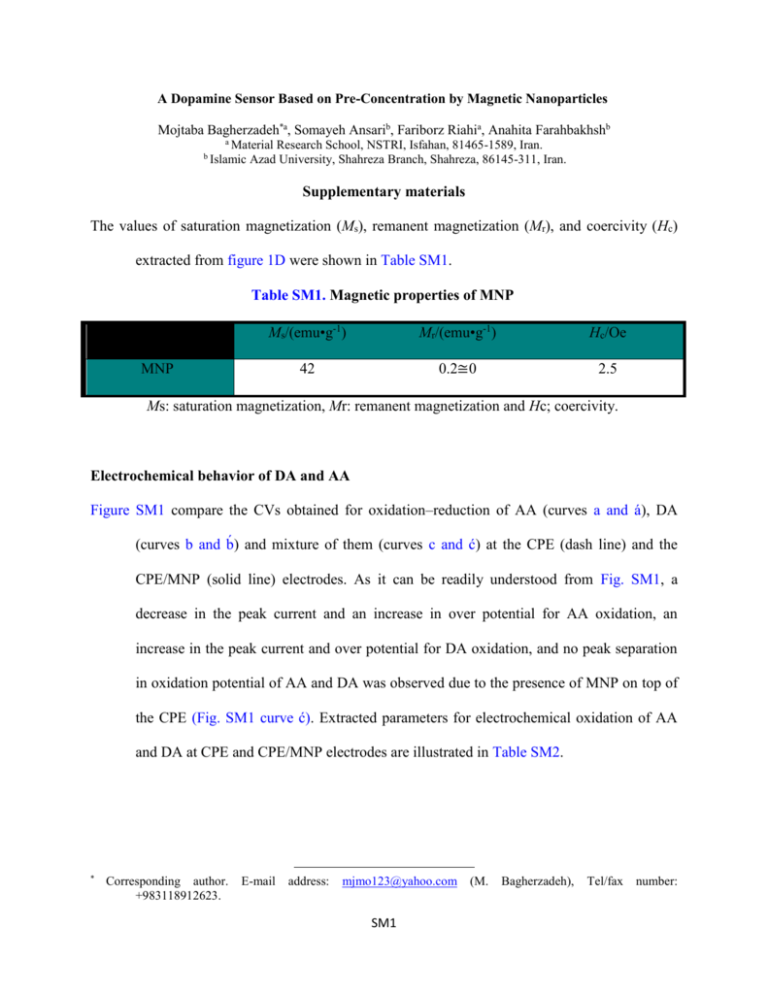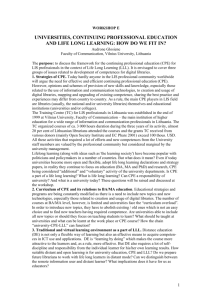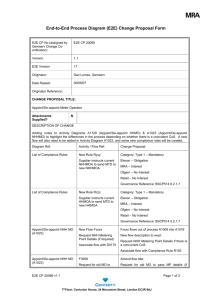Supplementary materials
advertisement

A Dopamine Sensor Based on Pre-Concentration by Magnetic Nanoparticles Mojtaba Bagherzadeh*a, Somayeh Ansarib, Fariborz Riahia, Anahita Farahbakhshb a b Material Research School, NSTRI, Isfahan, 81465-1589, Iran. Islamic Azad University, Shahreza Branch, Shahreza, 86145-311, Iran. Supplementary materials The values of saturation magnetization (Ms), remanent magnetization (Mr), and coercivity (Hc) extracted from figure 1D were shown in Table SM1. Table SM1. Magnetic properties of MNP Ms/(emu•g-1) Mr/(emu•g-1) Hc/Oe 42 0.2≅0 2.5 MNP Ms: saturation magnetization, Mr: remanent magnetization and Hc; coercivity. Electrochemical behavior of DA and AA Figure SM1 compare the CVs obtained for oxidation–reduction of AA (curves a and á), DA (curves b and b́ ) and mixture of them (curves c and ć) at the CPE (dash line) and the CPE/MNP (solid line) electrodes. As it can be readily understood from Fig. SM1, a decrease in the peak current and an increase in over potential for AA oxidation, an increase in the peak current and over potential for DA oxidation, and no peak separation in oxidation potential of AA and DA was observed due to the presence of MNP on top of the CPE (Fig. SM1 curve ć). Extracted parameters for electrochemical oxidation of AA and DA at CPE and CPE/MNP electrodes are illustrated in Table SM2. * Corresponding author. +983118912623. E-mail address: mjmo123@yahoo.com SM1 (M. Bagherzadeh), Tel/fax number: Fig. SM1. The cyclic voltammograms of the CPE (a, b, c) and the CPE/MNP (a`, b`, c`) obtained in 0.1 M PBS (pH 7.0), 0.1M NaClO4 solutions containing 1 mM AA (a,a`), 1mM DA (b, b`) and 1 mM AA and 1 mM DA (c, c`); scan rate: 100 mVs−1. Table SM2. Electrochemical parameter for oxidation of AA and DA on CPE and CPE/MNP electrodes, extracted from Fig. SM1. Analyte 0.1 M DA 0.1 M AA 0.1 M DA and 0.1 M AA Electrode ipa/µA CPE 87.88 CPE/MNP 165.2 CPE 64.66 CPE/MNP 41.20 CPE 137.9 CPE/MNP 307.5 * NO: Not observed SM2 ipc/µA -65.72 -111.8 NO* NO -49.91 -125.8 Epa/mV 335.7 425.0 305.9 345.6 385.3 464.6 Epc/mV 58.00 18.30 NO NO 97.70 67.90 Fouling effect of DA at CPE/MNP electrode Passivation of the CPE/MNP was comparatively studied. Electrochemical oxidation of DA at unmodified and some modified electrodes may lead to deposition of polymeric films on the surface that decreases the electrode activity (electrode poisoning or fouling effect) [1,2]. Thus, successive square wave voltammetric scans obtained for oxidation of DA at the CPE/MNP electrode was recoded (Fig. SM2 (A)), and the relative responses of ipa of DA were plotted vs. scan number (16 records) (Fig. SM2 (B)). As can be see the ipa of DA decreased at the CPE/MNP electrode with increases in the scan number. These results showed very unstable response for CPE/MNP electrode towards the DA oxidation, and there is fouling property against the oxidation products at the CPE/MNP electrode. 120 100 (A) (B) Scan 1 100 Relative responce % 80 i/ A 80 60 Scan 16 40 60 40 20 20 0 -0.2 0 0.0 0.2 0.4 0.6 0 2 4 6 8 10 12 14 16 Number of scans E/V (vs. Ag/AgCl) Fig. SM2. (A) Square wave voltammetric scans obtained for oxidation of 1 mM DA in 0.1 M PBS, pH 7.0 at the CPE/MNP electrode. (B) Relative responses of the anodic peak current, obtained during successive recording of 16 square wave voltammograms at the CPE/MNP modified electrode. SM3 References: [1] [2] J.A. Stamford, J.B. Justice, Anal. Chem. 68, 359A (1996). N. J. Ke, S. S.Lu, S. H. Cheng, Electrochem. Commun. 8, 1514 (2006). SM4









